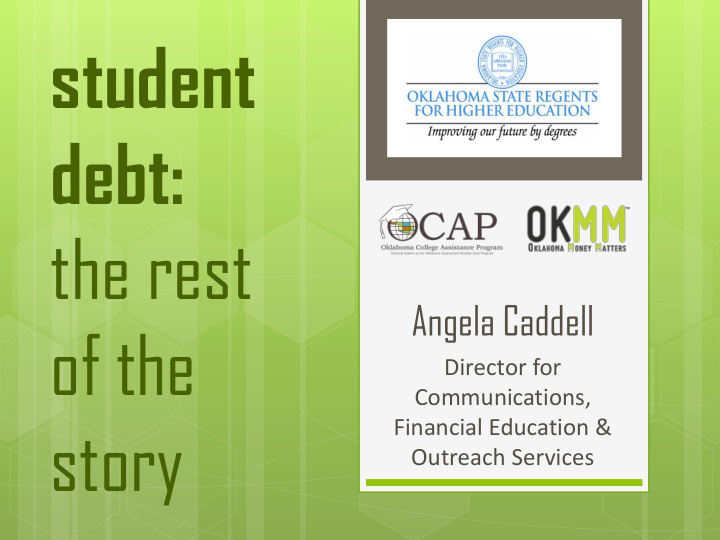



student debt: the rest Angela Caddell of the Director for Communications, story Financial Education & Outreach Services
The Numbers 2009 Average Student Debt Oklahoma $20,469 [OK 15% below national average] National $24,000 2010 Average Student Debt Oklahoma $20,708 [OK 18% below national average] National $25,250 2011 Average Student Debt Oklahoma $20,897 [OK 21% below national average] National $26,600 Source: Project on Student Debt, four-year public and private schools
The Numbers • Despite variances within sector types, both the overall average percent of borrowers and overall amounts borrowed by undergraduates in Oklahoma are below the national average • While the national average student loan debt is increasing approximately 5% per year, Oklahoma’s average debt is increasing only about 1% per year • Despite the hype, only about 3% of borrowers nationally owe more than $100K in student loans Sources: Integrated Postsecondary Education Data System, Federal Reserve System
The Challenge S TUDENT I NCOME & S TUDENT S AVINGS B ORROWING 12% 18% R ELATIVES & F RIENDS 4% P ARENT B ORROWING 9% G RANTS & S CHOLARSHIPS P ARENT I NCOME & 29% S AVINGS 28% How the Average American Family Pays for College Source: Sallie Mae, 2012
The Challenge • for many students, the first transition – from high school to college – is largely unsupported • down economy = shifting family priorities • the perfect financial storm – low family savings = increased reliance on home equity and/or private loans – credit crunch = decreased availability of home equity and private loans – many parents need financial education, too • roughly 30% of American adults admit they don’t know their credit score
The Challenge • student credit behavior – 20% of college seniors carry a balance greater than $7K – credit and debit card payments now account for more than 50% of spending among consumers ages 18-24 – 64% of consumers ages 18- 24 don’t know the interest rates they pay on their credit cards – many college students charge direct educational expenses • nearly 30% charged tuition • 92% of undergraduates charged textbooks, supplies Sources: Jump$tart Coalition, Experian, Sallie Mae
The Challenge N EW C REDIT T YPES OF C REDIT 10% 10% L ENGTH OF C REDIT H ISTORY 15% P AYMENT H ISTORY A MOUNTS O WED 35% 30% Do students understand the implications? [credit score composition]
The Challenge • called ‘Generation Y’ and ‘Millennials’ • a student loan was the first credit experience for many • “easy out” philosophy • sense of entitlement • connected 24/7 • inflated salary expectations
The Approach positive inspirational interactive – content • real-life stories • shared perspectives • quick bites of information • focus on solutions (not causes) • open discussion
The Approach – delivery method(s) YES! • traditional campus marketing • communication technologies • social media • guidance & conversation NO. • e-mail blasts • lecture
The Approach – venue • where do students gather organically? • where do you want them to spend time? • where is your message most relevant? – timing • when do students gather organically? • when is your message most relevant?
The Approach • multiple touchpoints build skills, change behaviors – skills – behaviors • developing a budget • using credit cards responsibly • completing the FAFSA • saving money • understanding my credit report • reviewing my credit report annually • balancing my checkbook • tracking my spending • teachable moments throughout collegiate lifespan
The Approach • multiple delivery mediums – online – social media – face time: in courses – face time: in workshops – address all learning styles, if possible • visual • auditory • kinesthetic
The Approach • audience assessment – what do students value? – what do students know? – what do students need to know? – how do students want to learn? » focus groups » town hall meeting » student task force
Solutions • key messages – higher education is an investment in future earning potential – if you must borrow to cover school expenses, exhaust all federal loan options before considering private or ‘alternative’ loans – don’t accept loan funds you don’t need; borrow only what you need to pay school expenses
Solutions • key messages – research scholarship options every year; eligibility requirements change and new programs are added – reconsider your need for loan funds every semester – pay attention to your total amount borrowed as you go, and keep your expected first-year salary in mind
Solutions • integrate financial education budgeting bu ing within existing programs & services credit – workshops and seminars – instructional materials student nt loan management – train-the-trainer support – Web text and eNewsletters savings – online tools – Facebook\ OklahomaMoneyMatters identity ty theft – Twitter\ OKMoneyMatters
Solutions • full customization – to reflect the campus – to reflect the students – to complement existing services • program consulting & execution – assess educational needs – brainstorm delivery options – facilitate activities – implement service strands
Default Prevention Solutions • for campus partners – entrance and exit counseling tools – Default Prevention School Tool (DPST) – cohort default rate analysis – default management plan consulting – networks to share best practices • for student borrowers – debt management workshops – materials and tools to support successful repayment – Facebook/ RepaymentScoop
Angela Caddell 405.234.4495 acaddell@ocap.org www.OklahomaMoneyMatters.org
Recommend
More recommend